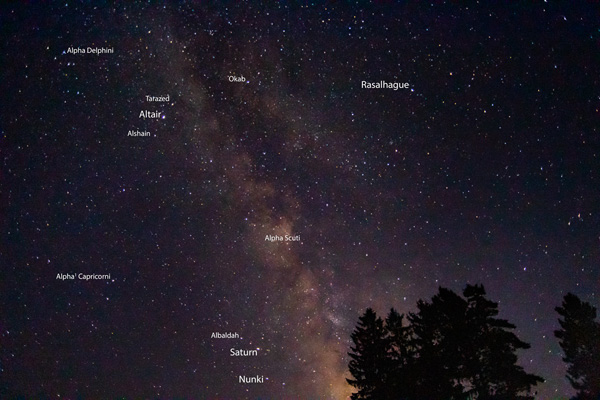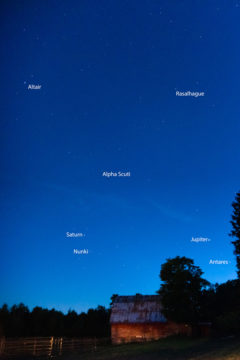Altair Vitals
| Official name (IAU-approved) | Altair |
| Other Designations | HIP 97649, Alpha Aquilae, HR 7557 |
| Nicknames | -- |
| Apparent magnitude | 0.76 |
| Distance from Earth | 16.7 light-years |
| Type | Main sequence? A7IV-V |
| Color | White |
| Mass | 1.83 M☉ |
| Radius | 1.79 R |
| Constellation | Aquila |
| Right Ascension | 19h 50m 47s |
| Declination | +08° 52' 06” |
| Multiple system? | No |
| Variable star? | No |
| Exoplanets status | None known |
| Probable fate | Planetary nebula/white dwarf |
Physical Characteristics
Altair is the twelfth-brightest star in the night sky and one of the closest stars to Earth, at a distance of only 16.7 light-years. Altair appears to be on the main sequence, where stars still burn hydrogen in their cores, but it’s almost twice the Sun’s size and mass. It’s possible that Altair has begun to utilize helium in the core, and therefore could be on the way towards becoming a subgiant star.

Occasionally we find stars (Regulus and Vega are two examples) that are rotating so rapidly, their shape begins to stretch as a result. Altair falls into this category. Completing a full rotation every 10 hours, Altair’s equator is moving at roughly 290 kilometers a second — that’s equivalent to about 650,000 miles per hour. To put this number into perspective, consider Jupiter. The giant planet also rotates every 10 hours but with only 10% of the Sun’s girth, its equator travels only about 13 kilometers per second (30,000 mph).
Stars typically appear as featureless points of light no matter what telescope is used or how much magnification is applied, but due to Altair’s size and proximity, we can see the actual surface of this star. Astronomers at the Center for High Angular Resolution Astronomy (CHARA) have directly imaged Altair, using CHARA’s Mid-Infrared Combiner to capture its oblate shape. The images also reveal general surface details, such as the fact that Altair’s equator is darker — and therefore cooler — than its polar regions. Like its shape, Altair’s dark equator is due to its rapid spin. The effect, known as gravity darkening, was first predicted in 1924.
Origin / Mythology
The star’s Arabic name is Al Nasr Al-Tair, meaning “The Flying Eagle,” an apt name for the brightest star in a constellation that is presented as an eagle across multiple cultures. Ancient Greeks, Babylonians, Egyptians, Sumerians, Aboriginal Australians — all of them shared the concept of Aquila as an eagle or predatory bird.
However, in one charming Chinese myth, Altair has nothing to do with an eagle, but instead represents a humble cowherder. He is in love with the Sky Emperor’s daughter, a weaver represented by the star Vega. The two were banished on opposite sides of a river, symbolized by the Milky Way, that they cannot cross. Happily, once a year, a flock of magpies build a bridge across the Milky Way so that the cowherd and the weaver might briefly reunite. Similar tales of star-crossed lovers represented by these two stars exist in Japan and Korea.
How to See Altair

If you’ve never seen Altair (or at least have never identified it), you’ll find the star satisfying and fun to locate, primarily because of its brightness but also because of its location.
Altair is one of three stars that make up the Summer Triangle, the other two being Deneb and Vega. While the Triangle can be viewed during seasons other than summer, it’s fun to go looking for it in July or August because it is very high up in the sky, close to the zenith. When looking for Altair, keep in mind that Summer Triangle isn’t equilateral; it’s closer in shape to a right triangle. This fact especially helps with identifying Altair, as Altair is the one star of the triangle that is farther away from the other two. Watch out for Rasalhauge — it’s another bright star nearby but is not part of the triangle. Altair itself has two dimmer, line-of-sight companions on either side of it, Alshain and Tarazed.
And say, while you’re in Aquila, take a quick jump down to Lambda Aquilae — the Eagle’s “tail.” Somewhere in the blank area between Lambda Aquilae and Scutum (the Shield) is the 1973 Pioneer 11 spacecraft, speeding on toward the space between stars.
It doesn’t take eagle eyes to see the Eye of the Eagle . . . have fun viewing Altair.
 0
0









Comments
You must be logged in to post a comment.